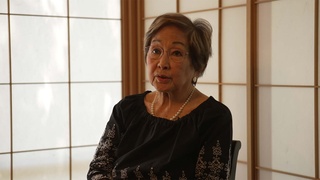Interviews
Working in cane fields as teenager to supplement family income
Well, when I was 12, 14 years old, all the kids used to work in the cane field those days during the summer. You worked for about maybe two and a half months during the summer and try to make as much money as you can. And those days, you work a whole day and they pay you only 25 cents a day. But, we all had to work to help because my father was working in the cane field all day, 12, 14 hours a day, and he'll come home and make only about $70 or $80 a month. So when you have seven kids, you know, that's not enough. So, during the summer, my brother, myself, my sister, we all try to help out to try to make as much money we can. So, I used to work in the cane field, get up maybe 4 o'clock in the morning and go to cane field and cut grass. And I used to hate that job because, you know, the leaves would cut you and all that.
Date: December 16, 2003
Location: Hawai'i, US
Interviewer: Art Hansen, John Esaki
Contributed by: Watase Media Arts Center, Japanese American National Museum.
Explore More Videos

Japanese language education for children
Professor of Law, University of Sao Paulo, Lawyer, Translator (b. 1948)

Speaking about his wife
(1928 - 2008) Drafted into both the Japanese Imperial Army and the U.S. Army.

Growing up with both Japanese and American influences
(1919-2020) Member of the 1800th Engineering Battalion. Promoted Japan-U.S. trade while working for Honda's export division.


My daughter’s identity (Japanese)
(b. 1979) Sansei Nikkei Brazilian who lives in Oizumi-machi in Gunma prefecture. He runs his own design studio.

What I wanted to pass down to my children (Japanese)
(1928 - 2008) Drafted into both the Japanese Imperial Army and the U.S. Army.

Backstory of Parents
(b. 1939) a businesswoman whose family volunterily moved to Salt Lake City in Utah during the war.


Coming home to his mother after the war
(1919 - 2015) Nisei who served in World War II with the 442nd Regimental Combat Team

Marriage and Family
(1914–2015) Nisei YMCA and Japanese American community leader

Father created a partnership to grow and ship vegetables
(b. 1935) Sansei businessman.

Taking over his father's business after father's accident
(b. 1935) Sansei businessman.

His family Traveled to Japan in 1940
(b. 1938) Japanese American. Hiroshima atomic bomb survivor

Grandfather migrating to Colombia
(b.1974) Japanese Colombian who currently resides in the United States

Early Childhood
(1914–2015) Nisei YMCA and Japanese American community leader
